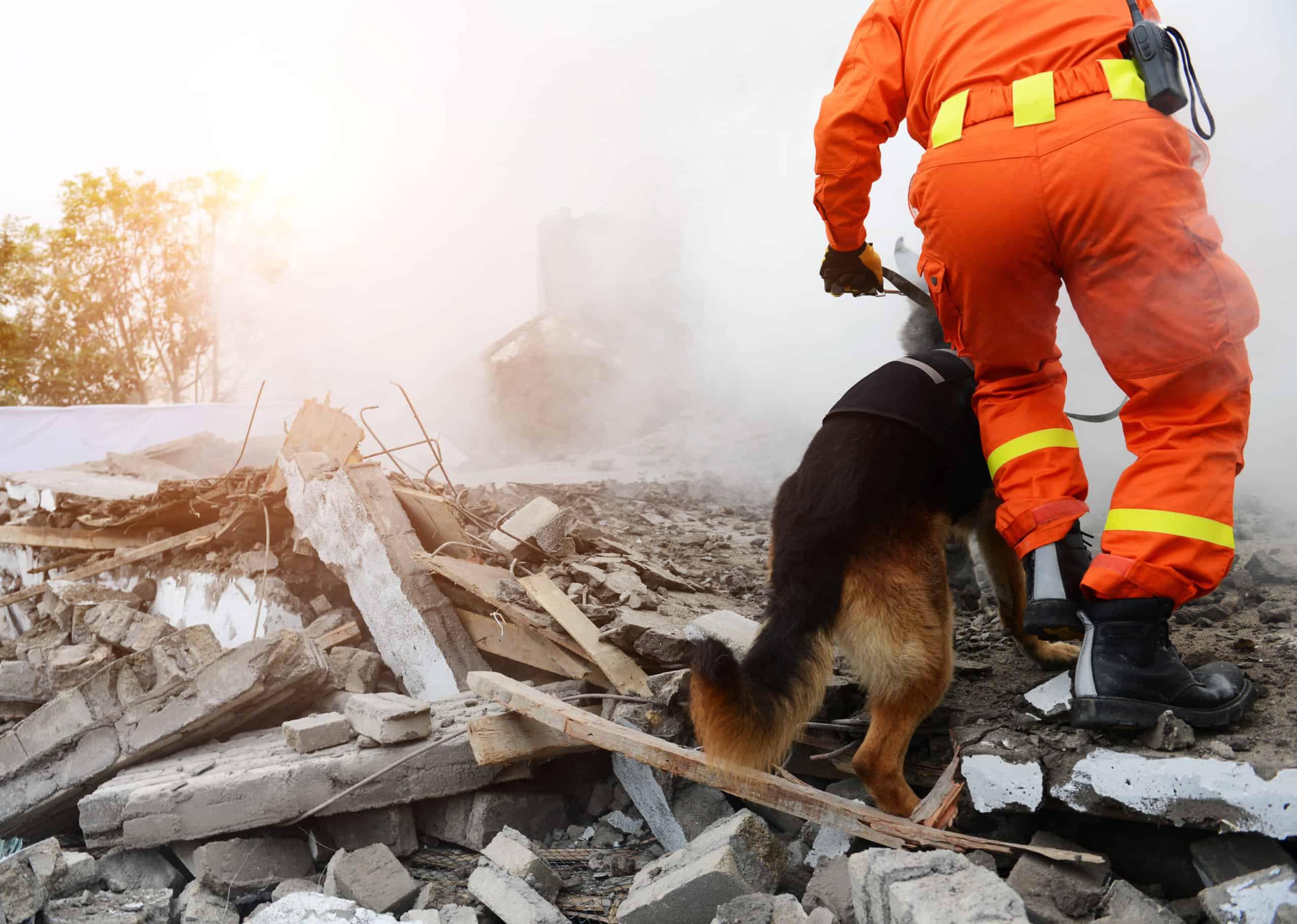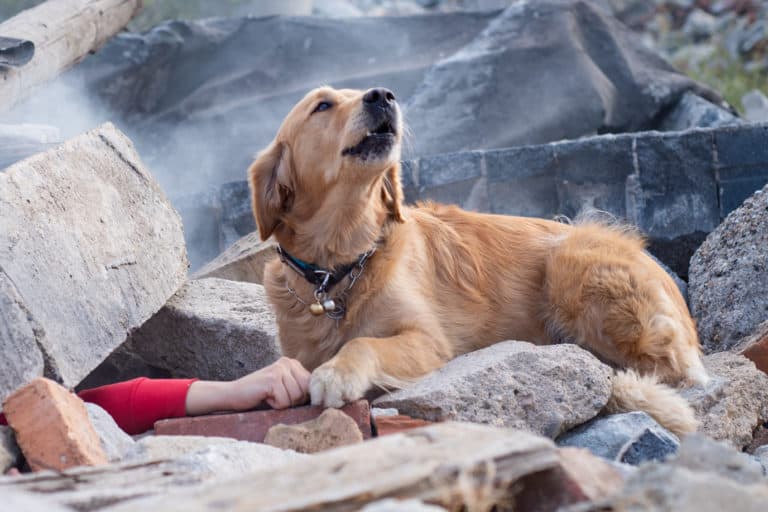In our most recent blog article, we explored the different types of Search and Rescue dogs that can be trained to find humans. The power of a dog’s nose to distinguish scent and be deployed in a variety of settings is truly awe-inspiring, and is why dogs continue to be used for many important jobs.
In addition to finding living people, dogs can be trained to locate the remains of deceased individuals. Human remains detection (HRD) dogs (also known as cadaver dogs) are deployed by law enforcement agencies, search and rescue units, or private personnel in cases where an individual is presumed to be deceased. Dogs can assist law enforcement teams in missing person cases, and bring closure to concerned families. A well-trained cadaver dog is an incredible asset to law enforcement, forensic investigators and other parties who require identification of human remains.
When first considering this subject, your mind may wander to several different places. Why use dogs to locate human remains? How are cadaver dogs actually trained? What makes a dog a good candidate for this type of work? And are they actually successful in their work? In this article, we will provide comprehensive answers to each of those questions.
What do cadaver dogs do?
Using their extraordinary sense of smell, dogs can be trained to locate the scent of decomposing human remains. HRD dogs will use either an active or a passive alert as their trained final response (TFR). The operational environment plays a significant role in choosing what type of alert a cadaver dog will be trained on. In most cases, we train to a bark or scratch alert, sometimes a combination of both. However, in the circumstances of a water HRD dog, a passive alert such as a sit or down may be the best option.
Human remains detection dogs can be deployed in any situation in which an individual is presumed to have passed away. This could include:
– In the aftermath of a natural disaster or terrorist attack when rubble from damaged buildings may have resulted in individuals being buried.
– If an individual has gone missing while on a hike or other outdoor activity, and it is suspected that they may no longer be alive. This is either because enough time has elapsed since the person first went missing and/or live-find SAR dogs have been unsuccessful.
– In a criminal investigation where it is suspected that the person may have been killed, and the remains are suspected to have been disposed of within a certain area.
– If it is suspected that an individual may have drowned, a water HRD dog can be deployed.
– In any situation where a live-find SAR dog has been unable to locate the individual, and it is presumed that they may be deceased.
In all of these circumstances, HRD dogs possess unparalleled skills.
Why are cadaver dogs valuable?
In cases where an individual is presumed to be deceased, there are two main parties who stand to benefit greatly from the work of an HRD dog.
The first is the law enforcement team that is deploying the HRD dog. Police departments and criminal investigators can use HRD dogs to help understand the circumstances surrounding a death, which can help bring justice where necessary.
Perhaps more importantly, a cadaver dog can help bring closure to families. When a person has been missing for a long period of time, family members may start to fear the worst; however, without actual identification of human remains, they may still hold out hope that their loved one may be found. Although confirmation of death is undoubtedly traumatic, it is the first step to processing the trauma and dealing with the associated grief.
What are the benefits of using cadaver dogs?
There are three primary reasons for using dogs to find human remains – accuracy, speed and stamina.
Accuracy – We have spoken about the power of a dog’s nose. Because dogs can locate a fraction of odor in a large area, and can distinguish between the different odors of living humans and decomposition, they are the most accurate way to locate human remains.
Speed – Not only can dogs discover tiny particles of odor in large areas; they can cover those large areas far more quickly than humans ever could. This means that searches can be completed in less time, increasing operational efficiency.
Stamina – Many dog breeds used in cadaver work have been bred for centuries for their working qualities. These dogs have a tireless work ethic and will continue to work, even in tough terrain and harsh weather conditions.

What are the different types of cadaver dogs?
Different types of cadaver dogs are deployed for different purposes. Land cadaver dogs are the most common type of HRD dog and are used to cover large areas such as fields, woodlands and other open areas. They can also be deployed in domestic settings such as homes and barns.
Disaster cadaver dogs work in demanding environments, typically in the aftermath of a large-scale natural or manmade disaster. These dogs are used when an operation transitions from a live-find situation to a recovery mission.
Lastly, water HRD dogs are deployed in bodies of water such as lakes and rivers. They are able to locate bodies in fresh and salt water as well as deep and fast moving bodies of water. In a typical search they ride with their handlers on boats, and can detect odor molecules that rise up from the water but sometimes they may start their search from the bank of a moving body of water. All of these techniques help to pinpoint where a body may be located at the bottom of the water.
The training process for the three types of cadaver dog will vary to take into account the intricacies with each. The three types of training can be combined such that a single dog can search in multiple environments or all three, and as such, that increases the difficulty and time it takes to train.
How are cadaver dogs trained?
Training a cadaver dog is an intensive process, requiring countless hours of investment in training and proofing the dog. When deployed in an active situation, an HRD dog must be able to consistently and reliably find anything from a full human body to a mere fragment or particle. This means that the training process has to capture all eventualities and must be designed to set the dog up for success when it becomes operational.
One of the single most important parts of training with a search and rescue dog is environmental stability. The dog has to be virtually “bullet proof” when it comes to its ability to be comfortable in the intended operational environment. Once you have completed the necessary evaluation, testing, and selection process for your future cadaver dog, the next step is to ensure you are working on confidence skills and obedience. This will include things like footwork, agility, various noises, night time training, and on and off leash obedience so that the dog is comfortable when it is deployed no matter the circumstance.
As with other detection disciplines, dogs are imprinted to the target odor over a period of time, whereby they are then able to recognize the odor and distinguish it from other scents. The nature of cadaver work provides some interesting and unique complexities in the training process. After all, if you’re training your dog for sport detection, buying essential oils online is easy enough. But obtaining training aids for an HRD dog? That isn’t so straightforward.
Trainers have two main options for training aids, using real material or using pseudo material also known as chemically formulated training aids (CFTAs). We will explore this topic in more detail in a future article. When training a cadaver dog the use of real training aids – that is to say, blood, bone, hair, teeth, and tissue that has been retrieved from a human being that has passed away may prove to be difficult to obtain, store, handle, and prevent from contamination. Alternatively, there are pseudo scents that can be used in the training process, such as those offered by companies like ScentLogix. Real aids and pseudo scents both have their supporters.
The trainer will use the training aids and work with the dog over a period of time constituting several months to over a year to ensure the dog can indicate consistently and reliably once operational. As time progresses, it is best to vary the duration and difficulty of the searches to ensure the dog doesn’t become accustomed to the same type of search each time. The training scenarios will be focused on the operational environment(s) where the dog is going to be deployed – so water HRD dogs will practice on ponds or lakes, disaster dogs will mainly train on rubble piles, and so on.
In summary
The unique obstacles posed in cadaver dog training – combined with the sheer amount of time that is required to be invested for it to be successful – make HRD dogs one of the most difficult to train. However, the vital outcomes that an operational cadaver dog can deliver mean that the training process is worth it.
At Black Hills K9 LLC, we can help you at all stages of the cadaver dog process. Whether you or your agency is in the early stages of considering a cadaver dog and is looking for guidance on dog selection and an overview of the training process, or if you have an operational HRD dog and are looking for refresher training, we are here to help you. Simply reach out to us at dogtraining@blackhillsk9.com for more information on our working dog training programs.


